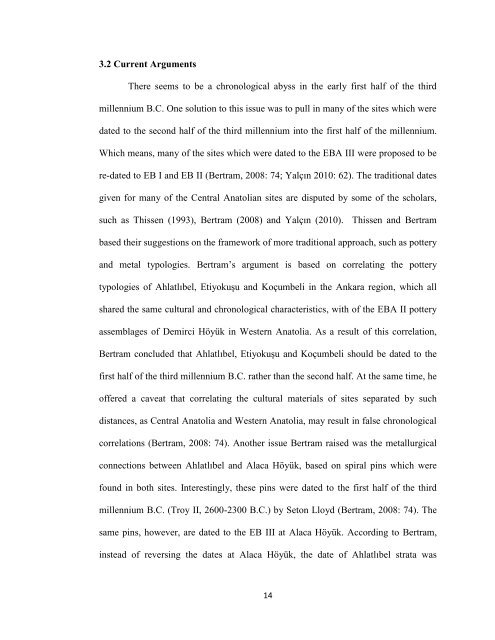EARLY BRONZE AGE DAGGERS IN CENTRAL ... - Bilkent University
EARLY BRONZE AGE DAGGERS IN CENTRAL ... - Bilkent University
EARLY BRONZE AGE DAGGERS IN CENTRAL ... - Bilkent University
Create successful ePaper yourself
Turn your PDF publications into a flip-book with our unique Google optimized e-Paper software.
3.2 Current Arguments<br />
There seems to be a chronological abyss in the early first half of the third<br />
millennium B.C. One solution to this issue was to pull in many of the sites which were<br />
dated to the second half of the third millennium into the first half of the millennium.<br />
Which means, many of the sites which were dated to the EBA III were proposed to be<br />
re-dated to EB I and EB II (Bertram, 2008: 74; Yalçın 2010: 62). The traditional dates<br />
given for many of the Central Anatolian sites are disputed by some of the scholars,<br />
such as Thissen (1993), Bertram (2008) and Yalçın (2010). Thissen and Bertram<br />
based their suggestions on the framework of more traditional approach, such as pottery<br />
and metal typologies. Bertram’s argument is based on correlating the pottery<br />
typologies of Ahlatlıbel, Etiyokuşu and Koçumbeli in the Ankara region, which all<br />
shared the same cultural and chronological characteristics, with of the EBA II pottery<br />
assemblages of Demirci Höyük in Western Anatolia. As a result of this correlation,<br />
Bertram concluded that Ahlatlıbel, Etiyokuşu and Koçumbeli should be dated to the<br />
first half of the third millennium B.C. rather than the second half. At the same time, he<br />
offered a caveat that correlating the cultural materials of sites separated by such<br />
distances, as Central Anatolia and Western Anatolia, may result in false chronological<br />
correlations (Bertram, 2008: 74). Another issue Bertram raised was the metallurgical<br />
connections between Ahlatlıbel and Alaca Höyük, based on spiral pins which were<br />
found in both sites. Interestingly, these pins were dated to the first half of the third<br />
millennium B.C. (Troy II, 2600-2300 B.C.) by Seton Lloyd (Bertram, 2008: 74). The<br />
same pins, however, are dated to the EB III at Alaca Höyük. According to Bertram,<br />
instead of reversing the dates at Alaca Höyük, the date of Ahlatlıbel strata was<br />
14
















